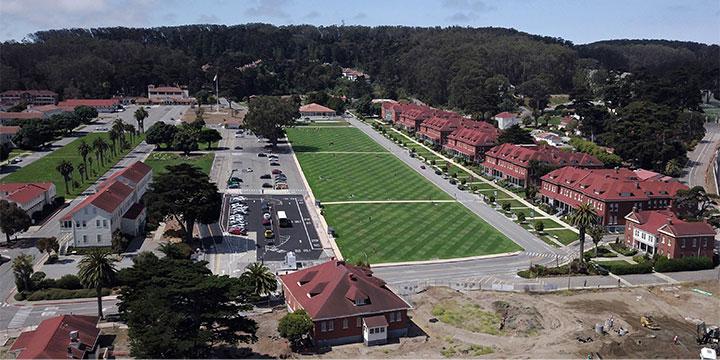May 24, 2021
Discover Five of the Presidio’s Rehabilitated Historic Buildings
The Trust has overseen the rehabilitation of over 400 historic buildings and structures.As an army post founded by the Spanish Empire back in 1776, there are currently hundreds of historic buildings and structures in the Presidio that together tell the story of its 218 years history. The Presidio was designated a National Historic Landmark District because of this concentration of historic features, and it’s a key reason why it was made a part of the national park system instead of being divided and sold (as was the case with many other decommissioned military bases).
Historic Preservation at the Presidio
Since the Presidio Trust’s creation in 1996, preserving and protecting these historic features has been a key part its mission. Most rehabilitation projects in the Presidio fall into the category of “adaptive re-use”, which updates a historic building for contemporary use without damaging its historic character.
To date, the Trust has overseen the rehabilitation of over 400 historic buildings and structures for new users , often in partnership with third-party developers. This body of work includes all of the historic residences in the park, which today provide housing for many of the Presidio’s 3,000 residents. In all cases, the Trust has ensured historical integrity and adherence to preservation standards and we’ve received numerous awards for this work, including twelve from the California Preservation Foundation, two California Governor’s Awards, three from the National Trust for Historic Preservation, as well as awards from the California Heritage Council and the American Institute of Architects, among others.
Here are five examples of successful rehabilitation in the Presidio:
Presidio Officers’ Club
Most recently rehabilitated in 2014 in partnership with the local architecture firm Perkins + Will, the Presidio Officers’ Club has had many lives since it was a home to Spanish soldiers and their families in the early 1800s. Surviving adobe brick walls from that time still exist in the front of the building and were carefully restored, exposed, and seismically strengthened as a part of the project. After the U.S. Army began occupying the Presidio in 1847, the building served at different times as officers’ quarters, a home for laundresses, and the post’s headquarters (including court-martial room). In the 1880s it became the center of officers’ social lives with the addition of what is now called Moraga Hall, the site of many dances, performances, and receptions. The Presidio Officers’ Club is now a museum, restaurant, and special events venue.
Pershing Hall / Inn at the Presidio
The U.S. Army completed the construction of Pershing Hall in 1904 as a bachelor officers’ quarters (BOQ), replacing an earlier wooden BOQ that regularly caught fire and finally burned down in 1899. This building wasn’t just for bachelors, however. For several years in the 1910s and 1920s, it was the home to Mrs. Sue Merriman, a U.S. Army widow. As the manager of the Presidio Officers’ Club and co-founder of the Presidio Women’s Club, she played a key role in the post’s social life during World War I and for several years after. In 2012, the Presidio Trust opened the Inn at the Presidio, its first hotel in this building. Its rehabilitation received LEED Gold status and City of San Francisco recognition for its green building practices. The Inn at the Presidio is now a beloved San Francisco boutique hotel featuring 22 spacious accommodations, including 17 suites with original fireplaces.
Montgomery Street Barracks
All but one of this row of seven brick barracks have been rehabilitated since 2009 and are currently used by the Lodge at the Presidio, The Walt Disney Family Museum, Futures Without Violence, a restaurant, and assorted offices. The U.S. Army completed the five nearly identical barracks in the center of the row between 1895 in 1897 as it closed down small posts across the West and concentrated soldiers in better connected locations like the Presidio. They were a substantial improvement over the barracks Presidio soldiers had been living in before – with indoor plumbing, mess halls, kitchens, reading rooms, tailor shops, and barber shops. The barrack at the north end was built as a band barracks in 1909 and first housed the famous Third Artillery Band led by Bandmaster Armand Putz, an expert fencer. The one at the south end (built the same year) was last used by the U.S. Army as a band barracks for the equally famous Sixth U.S. Army Band, whose members at one time included the noted trumpeters Chet Baker and Herb Alpert.
Presidio Theatre
One of the most recent rehabilitation projects brought the Presidio Theatre back to life in 2019 as a community performing arts space, thanks to the efforts of the Margaret E. Hass Fund, in partnership with the Presidio Trust. The U.S. Army completed its construction in 1939 with funding from the New Deal era’s Works Progress Administration. It was the Presidio’s first dedicated movie theatre, although it also hosted some live events over the years, including performances of the radio shows of both Jack Benny and Bob Hope during World War II. The last movie the U.S. Army showed? Maverick, on August 28, 1994.
Public Health Service Hospital / Presidio Landmark
Completed in 2012, the Trust worked with Forest City Enterprises on its largest and most complex historic rehabilitation project to turn this six-story 1932 Public Health Service Hospital into the LEED Gold certified Presidio Landmark apartments, removing non-historic wings and restoring windows and the original brick façade. The hospital is unique in the Presidio in that it was not a U.S. Army building. It is on land the U.S. Army once leased to the Treasury Department for a U.S. Marine Hospital to treat ill sailors. By 1932, the Marine Hospital Service had expanded to become the Public Health Service, which also fought infectious diseases, and treated veterans and some government employees.
